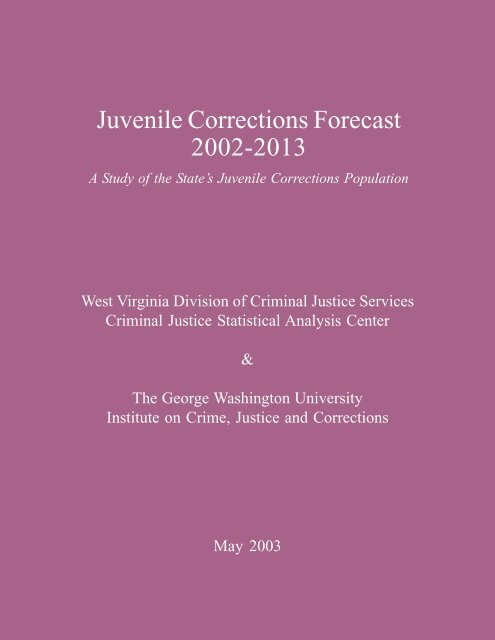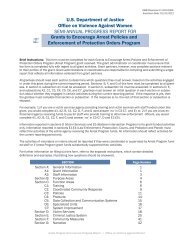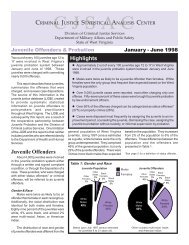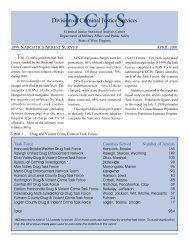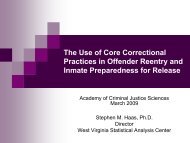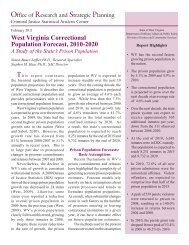WV Juvenile Corrections Forecast 2002-2013 - West Virginia ...
WV Juvenile Corrections Forecast 2002-2013 - West Virginia ...
WV Juvenile Corrections Forecast 2002-2013 - West Virginia ...
You also want an ePaper? Increase the reach of your titles
YUMPU automatically turns print PDFs into web optimized ePapers that Google loves.
<strong>Juvenile</strong> <strong>Corrections</strong> <strong>Forecast</strong><strong>2002</strong>-<strong>2013</strong>A Study of the State’s <strong>Juvenile</strong> <strong>Corrections</strong> Population<strong>West</strong> <strong>Virginia</strong> Division of Criminal Justice ServicesCriminal Justice Statistical Analysis Center&The George Washington UniversityInstitute on Crime, Justice and <strong>Corrections</strong>May 2003
1204 Kanawha Boulevard, EastCharleston, <strong>West</strong> <strong>Virginia</strong> 25301Phone: (304) 558-8814Fax: (304) 558-0391J. Norbert Federspiel, DirectorMichael Cutlip, Deputy Director - ProgramsDivision of Criminal Justice ServicesCriminal Justice Statistical Analysis CenterLaura N. Hutzel, DirectorTheresa K. Lester, Research AnalystThe George Washington UniversityWendy P. Naro, Senior Research Scientist/<strong>Forecast</strong>ing SpecialistThe U.S. Department of Justice provided funding for this project, through a grant made availableby the Bureau of Justice Statistics State Justice Statistics Program (Grant # 2001-BJ-CX-K018). Theopinions, findings, conclusions and recommendations expressed in this report are those of the authors andnot necessarily those of the U.S. Department of Justice.
Table of ContentsExecutive Summary ....................................................................... 5Introduction ................................................................................... 6Methodology ...................................................................... 6Technical Description of Model ......................................... 6Facility Descriptions ........................................................... 6Data Sources ...................................................................... 7Results........................................................................................... 8Flow of <strong>Juvenile</strong>s ................................................................ 8Commitments...................................................................... 9Releases ............................................................................ 13Length-of-Stay .................................................................. 14Confined <strong>Juvenile</strong> Population ........................................... 16<strong>Forecast</strong> Results .......................................................................... 22Key Assumptions.............................................................. 22<strong>Forecast</strong> ............................................................................ 22Recommendations ............................................................ 22
Executive SummaryThe Division of Criminal Justice Services’ (DCJS) Statistical Analysis Center partnered with The GeorgeWashington University’s Institute on Crime, Justice and <strong>Corrections</strong> to provide the state with this forecast ofthe juvenile corrections population from <strong>2002</strong> to <strong>2013</strong>. <strong>West</strong> <strong>Virginia</strong>’s juvenile correctional facilities, the<strong>West</strong> <strong>Virginia</strong> Industrial Home for Youth in Harrison County and the Davis Center in Tucker County, areoperated by the Division of <strong>Juvenile</strong> Services and house juveniles adjudicated delinquent by a judical officeror sentenced to a diagnostic examination by a judical officer. DJS also operates juvenile detention centers;these are not included in this report.This report describes the methods and statistics used to generate the juvenile forecast and is intended toinform policy-makers and planners about the forecasted population and the factors influencing the growth inthe juvenile corrections population.Between 1997 and <strong>2002</strong>, the juvenile corrections population in <strong>West</strong> <strong>Virginia</strong> grewby an average of 6.6% per year.The number of juveniles committed to corrections increased by an average of 2.6%per year between 1992 and 2001. In 2001, approximately 1 juvenile was committed for every1,000 juveniles between the ages of 10 and 17.Although the majority (76.5% in 2001) of commitments were white males, the percentof black males committed to corrections was 6 times greater than the percent of blackmales in the general <strong>West</strong> <strong>Virginia</strong> juvenile population. 11.3% of the commitments wereblack males. In the 2000 U.S. Census, 1.9% of juveniles between 10 and 17 in <strong>West</strong> <strong>Virginia</strong>were black males.Property offenses, including burglary, theft, and property damage, continued tocomprise the majority of offenses of juveniles committed to (55.6%) and confined in(50.0%) juvenile corrections. Person offenses, including assault, battery, sexual abuse, sexualassault, robbery, and homicide, were the second most frequent type of offense charged. 24.2% ofthe juveniles committed to corrections and 29.1% of the juveniles confined in corrections werecharged with a person offense.The majority of juveniles committed to corrections in 2001 were charged with onlyone offense. 8.8% of the juveniles committed four or more offenses for their current sentence.The average length-of-stay for juveniles released in 2001 was 9.7 months. The majorityof juveniles released in 2001 had been admitted in the prior year.If current trends continue unchanged, the juvenile corrections population will growto 222 by the end of 2007 and 279 by the end of <strong>2013</strong>.<strong>Juvenile</strong> <strong>Corrections</strong> <strong>Forecast</strong>5
IntroductionCurrent juvenile corrections population dataprovided by the juvenile correctional facilities and thejuvenile probation officers were used to generate thisreport. This report contains a description of themethodology and model used, descriptions of the datasources and correctional facilities, a statisticalsummary of recent trends, the assumptions uponwhich the projections are based, projections for the<strong>West</strong> <strong>Virginia</strong> juvenile correctional population throughthe year <strong>2013</strong>, and recommendations for continuingthese research efforts for the future.MethodologyThe forecast of the state juvenile correctionspopulation was completed using Wizard 2000projection software. This computerized simulationmodel mimics the flow of offenders through the state’sjuvenile corrections system over a ten-year forecasthorizon and produces monthly projections of keyoffender groups.Technical Description of the ModelThe Wizard 2000 simulation model utilizes atechnique that is consistent with that of a stochasticentity simulation model. It is stochastic, or probabilistic,in the sense that random numbers are used in themodeling process, and an entity simulation in the sensethat the model is conceptually designed around themovement of individuals through the correctionalsystem. The model is also generally an example of aMonte Carlo simulation technique because randomnumbers are used in the process of simulating thesystem. Individual cases (offenders committed tocorrections in <strong>West</strong> <strong>Virginia</strong>) are processed by themodel based upon probabilities fed in by theresearcher. These probabilities are different for eachoffender group: male drug offenders, male personoffenders, male property offenders, male public orderoffenders, female drug offenders, female personoffenders, female property offenders, female publicorder offenders, and diagnostic commitments.When a model is loaded with accurate data, it canbe reliable in forecasting a population as it will mimicthe actual flow of cases through the correctionalsystem being modeled. For the simulation model towork to its full potential, information must be gathereddescribing the population currently confined and allthe commitments and releases from the system for aprevious one-year period. 6<strong>Juvenile</strong> <strong>Corrections</strong> <strong>Forecast</strong>
<strong>Juvenile</strong> <strong>Corrections</strong> <strong>Forecast</strong> 7
ResultsFlow of <strong>Juvenile</strong>s<strong>Juvenile</strong>s who are committed to juvenilecorrections, either for a delinquency sentence or adiagnostic examination, are admitted to the <strong>West</strong><strong>Virginia</strong> Industrial Home for Youth (<strong>WV</strong>IHY) inSalem, <strong>West</strong> <strong>Virginia</strong>. Females must remain at<strong>WV</strong>IHY. Some male juveniles can be transferred toand from the Davis Center after admission to <strong>WV</strong>IHY.<strong>Juvenile</strong>s can be released from either facility.185 males and 19 females were committed to<strong>WV</strong>IHY in 2001. Of the 204 juveniles committed in2001, 27.5% (56) were released by the end of theyear, without being transferred to Davis. 50 of thesereleased juveniles were male and 6 were female.44.1% (90) remained at <strong>WV</strong>IHY, awaiting either arelease or a transfer to Davis. Of these, 77 weremales and 13 were females. 28.4% (58) weretransferred to Davis.5.2% (3) Davis inmates were transferred back to<strong>WV</strong>IHY. Of these, 2 were released and 1 wasawaiting release as of January <strong>2002</strong>. 34.5% (20)Davis inmates were released from Davis in 2001.60.3% (35) Davis inmates were awaiting release fromDavis as of January <strong>2002</strong>.The flow chart below shows only those juvenileswho were committed in 2001. 8<strong>Juvenile</strong> <strong>Corrections</strong> <strong>Forecast</strong>
CommitmentsSignificant Finding: The majority of juvenilescommitted to corrections were white males.Significant Finding: Black males were committedto corrections at a rate six times higher than theirproportion of the juvenile population. 11.3% of those committed in 2001 were blackmales. Only 1.9% of the juveniles between 10 and17 in <strong>West</strong> <strong>Virginia</strong> were black males.Significant Finding: The number of juvenilescommitted to corrections each year increased byan average of 2.6% per year between 1992 and 2001. <strong>Juvenile</strong> <strong>Corrections</strong> <strong>Forecast</strong>9
Significant Finding: Approximately 1 juvenile wascommitted to corrections for every 1,000 juvenilesbetween the ages of 10 and 17.In 2001, sixteen counties committed juveniles at arate higher than the average, led by Greenbrier Countyat a rate of 4.3 for every 1,000 juveniles.There were 396 offenses charged to the 204juveniles committed in 2001. These offenses arebroken down into broad categories which includeproperty offenses, person offenses, public orderoffenses, status offenses, and miscellaneous offenses.Table 3 provides the frequencies of offenses chargedto juveniles committed in 2000 and 2001.Significant Finding: Property offenses were themost frequent offenses charged to juvenilescommitted in 2001.Property offenses made up 55.6% of the offensescharged to those juveniles committed in 2001. Thenumber of property offenses increased between 2000and 2001, from 164 to 220 counts. Burglary, theft,and damage to property made up the majority of theproperty offenses in both years.Person offenses were the second most frequenttypes of offenses charged, at 24.2%. Assault andbattery comprised the majority of the person offensesin both 2000 and 2001. Sexual abuse and sexualassault increased from 5 counts in 2000 to 16 countsin 2001. 10<strong>Juvenile</strong> <strong>Corrections</strong> <strong>Forecast</strong>
The third most frequent types of offenses chargedto those committed in 2001, were public orderoffenses at 11.9%. Although weapons offenses werethe most common type of public order offense in 2001,there were fewer counts in 2001 (10 counts) than in2000 (13 counts).Drug law violations comprise 6.3% of the offensescharged to those committed in 2001.There were 6 counts of status offenses chargedto those committed in 2001, at 1.5%. This percent isdown from 2000, when the status offenses comprised3.1% of offenses charged.There were only 2 counts of miscellaneousoffenses charged to those committed in both 2000and 2001. <strong>Juvenile</strong> <strong>Corrections</strong> <strong>Forecast</strong>11
Significant Finding: Of those juveniles committedto corrections in 2001, more than half (51.5%)had only been charged with only one offense.Those charged with two offenses made up 25.0%of those committed. Those charged with three offensesmade up 14.7% of those committed. Only 8.8% ofthose committed to corrections were charged withfour or more offenses.The ages of juveniles committed in 2001 rangedfrom 11 years to 19 years old. The average age ofthose committed in 2001 was 16.6 years old. Theaverage age for males committed was 16.7 years old.The average age for females committed was 16.3years old. 22.1% of the juveniles were 18 or 19 yearsold. Graph 3 describes the age and gender of juvenilesat commitment. 12<strong>Juvenile</strong> <strong>Corrections</strong> <strong>Forecast</strong>
ReleasesSignificant Finding: 196 juveniles were releasedfrom juvenile corrections in 2001. The majorityof these juveniles had been admitted to juvenilecorrections in 2000.Of the juveniles released in 2001, 99 had beenadmitted in 2000 and 77 had been admitted in 2001.Very few were admitted prior to 2000: 17 in 1999, 2in 1998, and 1 in 1997.Of the 196 juveniles released in 2001, 73.5% (144)were white males. 13.3% (26) of the releases wereblack males. 8.5% (17) of the releases were females.<strong>Juvenile</strong> <strong>Corrections</strong> <strong>Forecast</strong>13
Length-of-StaySignificant Finding: The average length-of-stayfor juveniles released in 2001 was 9.7 months.Significant Finding: The average length-of-staywas 10.7 months for black males and 9.7 monthsfor white males.Significant Finding: One black male had a lengthof stay of 48 months. When this individual wasremoved from the average for black males, theaverage decreased to 9.2 months. The graphincludes this juvenile to demonstrate how unusualthis length-of-stay is.78.1% (153) of juveniles released in 2001 had alength-of-stay of 12 months or fewer.The most common length-of-stay was 7 months.35 juveniles were released after staying exactly 7months.179 males were released in 2001. Those that werecharged with public order offenses stayed the longest,an average of 10.8 months. <strong>Juvenile</strong>s released afterserving time for drug law violations had stayed anaverage of 8.5 months, the shortest of any maleoffender group. Males released for person offenseshad an average length-of-stay of 8.9 months.Of the 17 females released in 2001, only 15 werediscussed in Table 5 due to low numbers for the drugand public offense categories. Person offensesreceived the longest average length-of-stay forfemales at 13.8 months. This is a much longer lengthof-staycompared to the male length-of-stay for thesame offense at 8.9 months. Caution should be usedwhen interpreting these figures because the femalepopulation is much smaller than the male population.Like the males, the majority of the females released(10) were in the property offense category. Femalescharged with a property offense had an averagelength-of-stay of 6.7 months.14<strong>Juvenile</strong> <strong>Corrections</strong> <strong>Forecast</strong>
<strong>Juvenile</strong> <strong>Corrections</strong> <strong>Forecast</strong>15
Confined <strong>Juvenile</strong> PopulationThe confined juvenile population refers to thosejuveniles who are confined in a facility on any givenday. In this section of the report, the confinedpopulation of <strong>WV</strong>IHY and Davis represents juvenilesconfined on May 28, <strong>2002</strong>.Significant Finding: As of May 28, <strong>2002</strong> 1juvenile was confined in <strong>West</strong> <strong>Virginia</strong> for every1,000 juveniles between the ages of 10 and 17.Eighteen counties, led by Pocahontas County’s rateof 3.2 per 1,000 juveniles, confined juveniles at a rateabove the state average.Most (46) of the juveniles confined on May 28,<strong>2002</strong> were admitted earlier in the same month. 71were admitted prior to May, but in <strong>2002</strong>. 55 juvenileswere admitted in 2001, 9 in 2000, and 1 in 1999. SeeGraph 8.On May 28, <strong>2002</strong> the confined juvenile populationconsisted of 161 males and 22 females. 72.1% (132)were white males, 13.7% (25) were black males, and2.2% (4) were categorized as other males. 11.5%(21) were white females and 0.5% (1) werecategorized as other females. See Graph 9. 16<strong>Juvenile</strong> <strong>Corrections</strong> <strong>Forecast</strong>
On May 28, <strong>2002</strong>, 150 of the total juvenile confinedpopulation were confined at the <strong>WV</strong>IHY. 25.7% (47)were housed in the general population unit, at the<strong>WV</strong>IHY. 16.4% (30) were housed in the diagnosticunit. 14.8% (27) were housed in the adult transferunit. 8.7% (16) were housed in the female unit and14.8% (27) were housed in the admission andorientation unit. <strong>Juvenile</strong>s are also confined in jail orin the Davis Center. 1.6% of the juvenile confinedpopulation were temporarily located in a local orregional jail. 33 juveniles, 18.0% of the total juvenileconfined population, were confined at the DavisCenter.Graph 10 describes the total juvenile confinedpopulation by facility and unit.Table 7 describes the offenses that were chargedto those juveniles who still remained confined as ofMay 28, <strong>2002</strong>. <strong>Juvenile</strong> <strong>Corrections</strong> <strong>Forecast</strong> 17
Significant Finding: The offenses charged to theconfined population were similar to the offensescharged to the admission population, suggestingthat all offenders stay approximately the sameamount of time.When the confined population is proportionally thesame as the committed population, in terms of theoffenses charged, it indicates that no particularoffender group is “stacking up” in the facilities. Forexample, in the adult corrections population, 10.6%of those admitted were charged with sex offenses,but twice as many (20%) of offenders confined onany given day were charged with sex offenses. Theiraverage length-of-stay is longer than most otheroffenders admitted, including, for example, DUIoffenders. Sex offenders “stack up” in the adultpopulation, whereas DUI offenders cycle through.Significant Finding: There were 358 offensescharged to the 183 juveniles confined at this time.Again, property offenses made up the majority ofthe offenses charged, at 50%. Breaking and entering(12.0%) and destruction of property (10.3%) werethe top two property offenses charged.Person offenses were the second most commontypes of offenses charged to the juveniles confinedas of May 28, <strong>2002</strong>, at 29.1%. Again, assault/batterymade up the majority of the person offenses. Bothsexual abuse/assault (4.7%) and murder/manslaughter(1.1%) increased slightly among the confined juvenilepopulation, as compared to the admission population.It is important to note that the 12 counts of attemptedhomicide, which comprised 3.4% of the personoffenses, were charged to a single juvenile.Public Order offenses were the third most commonoffenses charged to those confined as of May 28,<strong>2002</strong>, at 11.5%. This is similar to the 11.9% of publicorder offenses charged to the admission population.Weapons offenses were the most common publicorder offense in both populations. The weaponsoffenses increased slightly by 1.1% among theconfined population.Drug law violations, made up 7.3% of theoffenses charged to juveniles confined as of May 28,<strong>2002</strong>. This was a slight increase above the 6.3%charged to those admitted in 2001. 18<strong>Juvenile</strong> <strong>Corrections</strong> <strong>Forecast</strong>
Miscellaneous offenses increased by 1.5%among the confined population. There were 7 countscharged to those juveniles confined as of May 28,<strong>2002</strong> and there were only 2 counts charged to thosejuveniles admitted in 2001.There was only one status offense charged in theconfined juvenile population. There were 6 countscharged to those admitted in 2001. <strong>Juvenile</strong> <strong>Corrections</strong> <strong>Forecast</strong> 19
Significant Finding: The juvenile correctionspopulation grew by an average of 6.6% between1997 and <strong>2002</strong>.Significant Finding: In <strong>2002</strong>, the averagepopulation was 143 at <strong>WV</strong>IHY and 43 at Davis.At the end of 1997, 130 juveniles were confined.This increased to 179 by the end of <strong>2002</strong>. Thesefigures do not include juveniles who committed anoffense in juvenile corrections and were sentencedto serve time in a regional jail.Davis housed 39 juveniles at the end of <strong>2002</strong>, adecrease from 51 at the end of 1997. The populationat Davis decreased by an average of 4.4% between1997 and <strong>2002</strong>.<strong>WV</strong>IHY housed 140 juveniles at the end of <strong>2002</strong>,an increase from 79 at the end of 1997. The populationat <strong>WV</strong>IHY increased by an average of 12.6%between 1997 and <strong>2002</strong>. 20<strong>Juvenile</strong> <strong>Corrections</strong> <strong>Forecast</strong>
<strong>Juvenile</strong> <strong>Corrections</strong> <strong>Forecast</strong> 21
<strong>Forecast</strong> ResultsKey AssumptionsThe juvenile corrections population forecast in thisreport was completed using the Wizard 2000simulation and projections model. This model simulatesthe movements of offenders through the juvenilesystem based on known and assumed policiesaffecting both the volume of admissions into the systemand the lengths-of-stay for juveniles who are housedwithin the state’s two correctional facilities. Itsimulates the movements of individual cases, byoffense category, and projects each separately.The following key assumptions were used and havea significant impact on the projections results.A. The composition of future annual new courtcommitments is assumed to be the same as thecomposition of admissions between January 1,2001 and December 31, 2001.Projections in this report are based on admissionand release data provided by the state for the timeperiod January 1, 2001 to December 21, 2001. Thefiles provided represented all admissions and releasesfrom the <strong>Juvenile</strong> <strong>Corrections</strong> Database (<strong>WV</strong>IHY andDavis). Future admissions are assumed to “look like”these admissions in terms of the proportion of admittingcharges, length-of-stay, likelihood of release, andmethod of release.B. Separate forecasts were produced for thetotal juvenile population and diagnosticevaluation beds disaggregated by male andfemale.The simulation model used for this forecast wasconstructed to predict male and female juvenileoffender populations separately. It is important tonote for any simulation model the more disaggregatedthe offender data is, the more precise and accuratethe resulting forecast will be. The model was alsoconstructed by analyzing the gender based data byadmitting offense type. Constructing the model inthis manner will add precision and accuracy to theresulting forecast.C. Over the forecast period, new courtadmissions are projected to increase by anoverall average of 2.6% each year through theyear <strong>2013</strong>.The new admissions assumptions used in thisforecast were developed by combining historical trendsin juvenile corrections admissions for the past fouryears, the correlation between the historicaldemographic state population, the historical crime rate,and the projected demographic growth for the state.The juvenile corrections population forecastassumes that the number of annual new commitmentswill increase from 203 in 2001 to 276 in <strong>2013</strong>. Thisrepresents an increase of 73 inmates over the 11 yearperiod with an average annual increase of 2.6 percentper year. This admissions assumption is consistentwith what is being observed and forecasted acrossthe country.<strong>Forecast</strong>Significant Finding: If current trends continuewithout change, the juvenile correctionspopulation will grow to 222 by the end of 2007and to 279 by the end of <strong>2013</strong>.The following page contains the juvenile correctionspopulation projections. Projections are presented forall juvenile offenders, males, females, and diagnostics.Graph 13 illustrates the historical and projected juvenilecorrection populations from 1997 to <strong>2013</strong>.RecommendationsThis report is the first forecast of the juvenilecorrections population for state leaders and others touse to plan for the future. The authors of this reportwould like to offer several recommendations regardingits use and the production of future forecasts.#1: Ensure High Data Quality in New SystemsThe Division of <strong>Juvenile</strong> Services should becommended for the development of a new trackingsystem which they are currently implementing in alljuvenile facilities. The system will enable researchersto obtain valuable information about the juvenilepopulation without the burden of paper-and-pencil datacollection instruments. DJS should ensure thatmeasures are taken to ensure high data quality, suchas reviewing and cleaning data on a regular basis andconducting random data quality audits. DJS shouldalso continue to work with the Criminal Justice22<strong>Juvenile</strong> <strong>Corrections</strong> <strong>Forecast</strong>
Statistical Analysis Center to ensure that theappropriate data elements can be used for theforecast.#2: Produce Annual <strong>Juvenile</strong> <strong>Corrections</strong>ReportsThe Criminal Justice Statistical Analysis Center hasproduced several annual juvenile corrections statisticalreports, but this report is the first to include apopulation forecast. The CJSAC should continue toproduce this report and eliminate the shorter annualreports to prevent duplication of efforts and expenses.Future reports should assess annual changes in thetypes of juveniles committed to corrections and theircorresponding length-of-stay, to name two importantfactors. This information will allow the researchersand readers to assess the extent to which each factorcontributes to the changes in the population.#3: Continue to Cooperate with Researcherson the Topic of Racial DisparityThe Criminal Justice Statistical Analysis Center hasshared information, as well as technical assistance,with researchers studying the topic of racial disparity.The analyses by race and gender illustrate theusefulness of the CJSAC to these endeavors.#4: Request Additional Information andAssistanceThe authors of this report are available to answerquestions about the juvenile corrections population andassist others in using the information in this report.<strong>Juvenile</strong> <strong>Corrections</strong> <strong>Forecast</strong> 23


